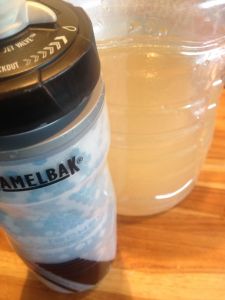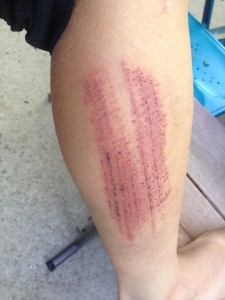Loving the BITE: “Arnold Palmer” Homebrew Sports Drink
 I think Arnold Palmer may have been onto something. Especially when it gets hot out, I like to use easy, refreshing homebrew drinks for fuel. Usually, I mix one made of fruit juice, water, and salt for rides 2 hours and less.
I think Arnold Palmer may have been onto something. Especially when it gets hot out, I like to use easy, refreshing homebrew drinks for fuel. Usually, I mix one made of fruit juice, water, and salt for rides 2 hours and less.
Depending on the time of day, I’ll use ice for some of the water portion. And, while this is a good option, I’ve been thinking, what about tea instead of water? Once or twice a week, I ride very early in the morning and the gentle, subtle caffeine in black tea would be a welcome addition. Or, if later in the day when I no longer want much caffeine, the refreshing taste and nutrients found in green tea may be just the ticket. Finally this last weekend, while enjoying some sweet singletrack in Gunnison, Colorado, I put it to the test. Here’s my simple tea-homebrew-sports-drink:
Recipe of the week: “Arnold Palmer” Homebrew Sports Drink
Ingredients:
- 10-14 ounces brewed green or black tea, chilled
- 1/8 tsp salt
- 10 oz. juice or lemonade
Instructions:
Mix all ingredients together. Drink 20-24 ounces per hour.
Nutrition Information: Per 20-24 oz. serving (per hour): 150 calories, 38 gram carbs, 300 mg sodium
Comments:
This drink may not have the perfect blend of glucose to fructose. It may not have maltodextrin, resistant starch, perfect 2:1 sugar ratios, or science-backed researched ingredients. But for a shorter ride of 2 hours or less, it will hit the spot. Here’s what it does have, all straight from nature:
Tea: Both green or black tea have an array of beneficial nutrients, most notably their cell-protecting antioxidants. These antioxidants can improve heart health, eye health, and more. Click on these links to read about the health benefits of both green tea and black tea leaves .
Caffeine: Black tea contains about 40-50 mg per 8 ounces, and green tea just 25-35 mg per 8 ounces on average. Caffeine has been shown in research to improve both mental and physical performance in training. In fact, it can give the cyclist the sense of less effort for the same amount of work. Of course, you don’t want to overdo it as too much caffeine at once can certainly be followed by what feels like a “low” energy spell. And, it does come with some risks (see below).
Carbohydrates from fruit juice: While I’m not a big fan of fruit juice for everyday consumption (I recommend eating whole fruits), it can be a good carbohydrate source for your ride. Most 100% juices have a 1:1 ratio or 1:2 ratio of glucose to fructose…and, I know, this is not the optimal best for glycogen replenishment (you’re usually going for a 2:1 glucose:fructose ratio as it has been shown to deliver the most accessible carbohydrates to the bloodstream while training). However, for shorter rides, many athletes do just fine with this mix, and it can be a nice break from powdered and “engineered” drinks. And, if using a drink that is not 100% juice, such as lemonade or some sort of juice “cocktail,” you may get a slightly different ratio with added sucrose (usually closer to the 2:1). If you want to add another carbohydrate source and increase the amount of carbs you’ll get per hour, try adding 10-15 grams maltodextrin per bottle.
Salt: Every 20-24 oz. bottle will contain 300 mg sodium. If you don’t have another sodium source, and are willing to push the sodium in your drink a little, you can go up to 1/6-1/4 tsp salt and see what you think (400-600 mg sodium).
 Like any sports drink, there’s give and take, and not every drink is a perfect fit for every rider. One risk with tea (especially black tea) is the potential of a natural laxative effect. This usually is not an issue when the tea is cold (rather than hot tea), but it’s a potential risk. I also consider this a greater risk to runners than to cyclists. Also, caffeine amounts can be difficult to determine with brewed tea, so if you’re especially sensitive to it, you may not want to use this drink.
Like any sports drink, there’s give and take, and not every drink is a perfect fit for every rider. One risk with tea (especially black tea) is the potential of a natural laxative effect. This usually is not an issue when the tea is cold (rather than hot tea), but it’s a potential risk. I also consider this a greater risk to runners than to cyclists. Also, caffeine amounts can be difficult to determine with brewed tea, so if you’re especially sensitive to it, you may not want to use this drink.
Alternatively, you can always opt to just use water, juice, and salt, or check out our coconut water sports drink recipe.
So, how did the tea-ride-test in Gunnison turn out? I had a great ride, pushed myself, and turned in some good times on both climbs and downhills throughout the Growler course (if you’re a mountain biker and are ever in the area, Hartman’s Rocks is an awesome place to ride). No stomach issues, and I very much enjoyed my drink. Unfortunately, it did not save me from leaving a bit of skin on the trail…but, it’s not magic and such is life on a bike (or off, rather). Whether you use this drink or another, I hope it hydrates you well too. Enjoy your ride, and your drink!
Fuel Your Ride. Nourish Your Body.


